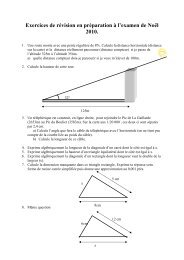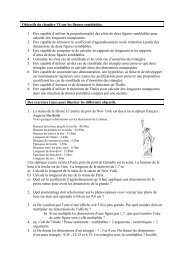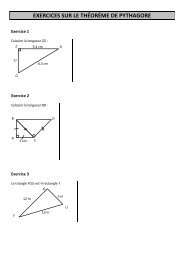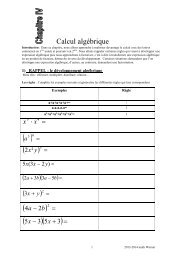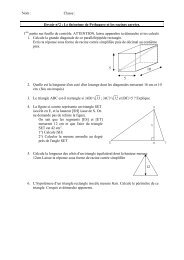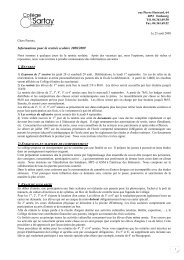Les mthodes de factorisation
Les mthodes de factorisation
Les mthodes de factorisation
- No tags were found...
You also want an ePaper? Increase the reach of your titles
YUMPU automatically turns print PDFs into web optimized ePapers that Google loves.
<strong>Les</strong> métho<strong>de</strong>s <strong>de</strong> <strong>factorisation</strong>Rappelons que :Factoriser signifie : transformer une somme en un produit.Comment reconnaître une somme ou un produit ?Une somme est le résultat <strong>de</strong> l’addition <strong>de</strong> <strong>de</strong>ux ou plusieurs termes.Exemples :(1) a + b + 3 est une somme <strong>de</strong> 3 termes : a, b et 3.(2) x − y + z − w est une somme <strong>de</strong> 4 termes : x , −y, z et −w.(3) a ⋅ b + c est une somme <strong>de</strong> 2 termes : a ⋅ b et c.Remarque : Ici on a utilisé la règle <strong>de</strong> priorité : « multiplication avantaddition ». L’expression est une somme parce que l’addition est la <strong>de</strong>rnièreopération à effectuer. De même :(4) 2x + 3( a + b)− 1 est une somme <strong>de</strong> 3 termes : 2 x , 3( a + b)et −1.Un produit est le résultat <strong>de</strong> la multiplication <strong>de</strong> <strong>de</strong>ux ou plusieursfacteurs.Exemples :(1) a ⋅b ⋅xest un produit <strong>de</strong> 3 facteurs : a , b et x .3(2)xy 2est un produit <strong>de</strong> 4 facteurs : 3 , x, y et12.Remarque : La division par 2 est équivalente à la multiplication par2 1 .(3) ( a + b)( x − 5)est un produit <strong>de</strong> 2 facteurs : a + b et x − 5 .Remarque : Ici la règle <strong>de</strong> priorité disant qu’il faut d’abord effectuer lesexpressions entre parenthèses a permis <strong>de</strong> reconnaître le produit. L’expressionest un produit parce que la multiplication est la <strong>de</strong>rnière opération àeffectuer. De même :(4) x 2 ( 2x + 1) est un produit <strong>de</strong> 3 facteurs : 2 facteurs x et le facteur ( 2x + 1).Exercice 1Analyser les expressions suivantes (c.-à-d. examiner s’il s’agit <strong>de</strong> sommes ou<strong>de</strong> produits et compter les termes respectivement les facteurs).(1) a ⋅ ( b + c)⋅ x(2) a + b⋅x −c(3) a ⋅b⋅ c + x(4) 3a + 2b −x − 5y+ 71
x + 1(5) y(6) ( x + y)(x − y)(7) ( a + 2) 2 ( x − 2y) 3(8) ( a + b) 2 −2ab− 5 + 73a(9)2xyz+ 1(10) 1− x( x + 3)(2− x)(11)2 + −3xa+ b−1x x+3(12)( )y−182<strong>Les</strong> trois métho<strong>de</strong>s <strong>de</strong> <strong>factorisation</strong> qu’il faut connaître sont : la mise enévi<strong>de</strong>nce, les produits (i<strong>de</strong>ntités) remarquables et le groupement <strong>de</strong>termes.A. La mise en évi<strong>de</strong>nceRappelons la propriété <strong>de</strong> distributivité <strong>de</strong> la multiplication par rapport àl’addition et à la soustraction :produitsa ⋅ ( b + c)= a ⋅ b + a ⋅ ca ⋅( b − c)= a ⋅b −a ⋅ csommesCette propriété permet <strong>de</strong> développer (ou effectuer) une expression, c.-à-d.<strong>de</strong> transformer un produit en une somme. Lorsqu’on lit les égalités dansl’autre sens, on transforme une somme en un produit, c.-à-d. onfactorise :a ⋅ b + a ⋅ c = a ⋅ ( b + c)a ⋅b −a ⋅ c = a ⋅( b − c)On dit qu’on a mis en évi<strong>de</strong>nce le facteur commun a.Remarque : On peut également mettre en évi<strong>de</strong>nce le signe – :Exercice 2−a − b = − ( a + b)− a + b = −( a − b)a − b = −( − a + b)a + b = −( −a − b)Factoriser les expressions suivantes en mettant en évi<strong>de</strong>nce les facteurscommuns :(1)sommes2xy + ax − x + x5 3 4(2) − 12ab + 36b − 48b c3 4 2 2 7 3(3) xy − xy + xy(4) 5( x − 4) + a ⋅( x −4)2(5) 2x( x + 3) − ( x + 3) + ( x + 3)(x − 2)produitsSi l’on met le – en évi<strong>de</strong>nce, les termeschangent <strong>de</strong> signe à l’intérieur <strong>de</strong>s ().2
2(6) −a−2ab−3a(7) − ( a + b) 2 − ( a + b)( 3a − b) + ( 7 − 3a)( a + b)(8) ( a 5)( 2a 7) a( 5 )− + + − a (Remarquer qu’il y a <strong>de</strong>s facteurs opposés !)(9) 14( 3 − 2a)( x + y) + 43( x − y)( 2a− 3)2(10) x( 3a 6) y( 4a 8) ( a 2)+ + + − + (Le facteur commun est bien caché …)2(11) ( x + x)( 2x −3) − ( xy + y)(8x+ 1)(Même remarque …)22(12) a ( a − 1)( 3a + 1) −a( 1 − a)( 15a + 5) −( a −1) ( −12a−4)(13) a( 3x + 5)( 30y −6) − 18b( 6x + 10)( 1−5y)2 3(14) 5a( a −b) ( a −2b) − 3( a + b)( a − b)5 4(15) 8( x + 4) − ( 2x + 8) ( x − 3)(16) ( 2−14x) 3 −x(7x−1)2Exercice 3Mettre en évi<strong>de</strong>nce le facteur indiqué en fin <strong>de</strong> ligne ou le signe – dans lesexpressions suivantes :(1) 3x− 18y+ 6 ; 3(2) 9a + 180 ; 9(3) a − b; –(4) 4x+ 6y− 2z; –2(5) 2x − 5y; 2(6) 3a −b −4c; –82 2 2(7) −a −b − c + d ; –2 5(8) a + a + 1 ; a3 2(9) 3b− 5b+ 4 ;2−3b 2B. <strong>Les</strong> produits remarquablesRappelons les i<strong>de</strong>ntités remarquables :a 2 + 2ab + b 2 = ( a + b) 2a 2 − 2ab + b 2 = ( a − b) 2facteur à mettre en évi<strong>de</strong>ncedouble produit précédé <strong>de</strong> + ou –2 2a − b = ( a − b)(a + b)différence <strong>de</strong> 2 carrés3
Remarques importantes :2 2• Ne pas confondre a − b = ( a − b)(a + b)2 2(1) a + c + 2ac2 2(2) − 2xy + x + y(4)4 2 34a+ 20a b + 25b 62 2169x− 52xy+ 4y(7) 18a + 2 − 12a(Mettre d’abord en évi<strong>de</strong>nce …)(11) 3z− 48(Le résultat doit comporter autant <strong>de</strong> facteurs que possible …)(14) a − 81b10 2(15) − a + 121y(Utiliser la commutativité …)(16) −( x − 2) 2 + ( 3x+ 1)2(17) ( a −1) −2( a − 1)b + b2et : ( a − b) = ( a −b)( a −b).• Une somme <strong>de</strong> <strong>de</strong>ux carrés a + b ne se factorise pas !Exercice 42Factorisez à l’ai<strong>de</strong> <strong>de</strong>s i<strong>de</strong>ntités remarquables. Mettre éventuellement d’abordun ou plusieurs facteurs communs en évi<strong>de</strong>nce ! Vérifier le double produit sinécéessaire.(3)(5)(6)2 29x− 4y2 2 2 2ay − 2abxy+bx2(8)2−9− x + 6x(9)2 22x− 2y(10)80y+ 20 + 80y4(12)4 4 2 2(13)ax + 1−2ax72xy −16y −81x2 2 4 44 422 2(18) 4( a + b) 2 − 25a 2 b22 2(19) 36( 2a + 3b) −9(a −5b)(20) 5( x + 3) 2 + 10( x + 3)( y − 4) + 5( y − 4) 25 4 3(21) − 3x + 12x − 12x2a2(22) − ab + b42a 121(23) +2− 114 a4 2 2 4x 5x z 25z(24) − +16 6 92x1−1− x + 1 5 9 22 2(25) ( ) ( )24
C. Le groupement <strong>de</strong> termesLa métho<strong>de</strong>s précé<strong>de</strong>ntes ne mènent pas toujours au but dans le travail <strong>de</strong><strong>factorisation</strong>. C’est notamment le cas lorsque les expressions à factorisercontiennent 4 termes ou plus. Dans ce cas il faut très souvent commencer pargrouper astucieusement les termes. Plus précisément :ax + ay + bx + byformation <strong>de</strong> 2 groupes= ( ax + ay ) + ( bx + by )= a( x + y) + b( x + y)mise en évi<strong>de</strong>nce dans les 2 groupes= ( x + y)( a + b)On met les termes qui vont ensemble entre parenthèses. Mais attention :lorsqu’un groupe <strong>de</strong> termes est précédé du signe –, on met ce – enévi<strong>de</strong>nce :ax + ay −bx −by= ( ax + ay ) − ( bx + by )= a( x + y) − b( x + y)= ( x + y)( a − b)Parfois un groupement prometteur au début ne mène à rien :2 2a −a − x + x( ) (2 2= a −a − x −x= a( a −1) −x(x −1)= ?Dans ce cas on essaie <strong>de</strong> grouper différement :2 2a −a − x + x2 2= a −x − a + x2 2( a x ) ( a x)= − − −= a − x a + x − a + x( )( ) ( )= a − x a + x − 1( )[( ) ])on commence par changer l’ordre <strong>de</strong>s termesformation <strong>de</strong>s groupeson effectue et simplifie l’expression entre [ ].= ( a − x)(a + x − 1)Exercice 5Factorisez en groupant convenablement les termes :(1) 3a + 6b −2bx −ax(2) 2x − 2a + 4−ax(3) 3x + ax −3−3y −a −ay(2 groupes <strong>de</strong> 3 termes ou 3 groupes <strong>de</strong> 2 termes)(4)2a −2a −ab − 2x + ax − bx5
(5) 169x 2 − 52xy + 4y 2 = ( 13x − 2y) 2(6) a 2 y 2 − 2abxy + b 2 x 2 = ( ay − bx ) 2(7) 18a 2 + 2 − 12a = 2( 9a 2 − 6a + 1) = 2( 3a− 1) 2(8) −9− x 2 + 6x = −( x 2 − 6x + 9) = −( x −3) 22 2 2 22x − 2y = 2 x − y = 2 x − y x + y(9) ( ) ( )( )(10) 80y + 20 + 80y 2 = 20( 4y + 1 + 4y 2 ) = 20( 2y+ 1) 2(11) 3z 4 − 48 = 3( z 4 − 16) = 3( z 2 − 4)( z 2 + 4) = 3( z − 2)( z + 2)( z2 + 4)(12)4 4 2 2(13)(14)ax+ 1−2ax2 2 2 2 2( ax )= − 2ax+ 12 2( ax 1)= −2= [( ax − 1)( ax + 1)]2 2= ( ax − 1) ( ax + 1)2 2 4 4272xy −16y −81x= −⎡⎢ 4y − 72x y + 9x⎣2 2 2 2( ) ( )2 2( 4y9x)= − −2 2= −( 2y − 3x) ( 2y + 3x)a4 4− 81b22 22 2 2 2( a 9b )( a 9b)= − +2 2( a 3b)( a 3b)( a 9b)= − + +10 2(15) − a + 121y2 10= 121y− a5 5= ( 11y − a )( 11y + a )(16) −( x − 2) 2 + ( 3x+ 1)22 2= ( 3x+ 1) −( x −2)= [( 3x + 1) −( x − 2)][( 3x + 1) + ( x − 2)]= ( 2x+ 3)( 4x− 1)2 2(17) ( a −1) −2( a − 1)b + b2 2= [( a −1)− b] = ( a −b− 1)(18) 4( a + b) 2 − 25a 2 b2= [ 2( a + b)− 5ab] [ 2( a + b)+ 5ab]= ( 2a + 2b − 5ab )( 2a + 2b + 5ab)2 2(19) 36( 2a + 3b) −9(a −5b)⎤⎥⎦Une somme <strong>de</strong> 2 carrés ne se factorise pas.10
2 2= 942 ⎡ ( a 3b) ( a 5b)⎤⎣ + − − ⎦= 9[ 2( 2a + 3b) −( a − 5b)][ 2( 2a + 3b)+ ( a − 5b)]= 9( 3a + 11b)( 5a + b)(20) 5( x + 3) 2 + 10( x + 3)( y − 4) + 5( y − 4) 222= 5⎡( x + 3) + 2( x + 3)( y − 4) + ( y − 4)⎤⎣⎦= 5[ ( x + 3) + ( y − 4)]= 5( x + y − 1)5 4 3(21) − 3x + 12x − 12x5 4= − 3x+ 12x− 12x2323 2= −3x ( x − 4x+ 4)3 2= −3x( x −2)2a2 222(22) − ab + b =4( a ) −2⋅ a ⋅ b + b =2 2( a − b2)a2 121 a 11(23) ( ) 2+2+ 11 = −4 a 2 a4 2 2 4 2 2 2 2 2 2 2 25 25 5 5 5(24)x x z z x 2x z z x z2⎛ ⎞ ⎛ ⎞ ⎛ ⎞− + =16 6 9 − ⋅ ⋅ + = −⎜ 4 ⎟4 3 3 ⎟⎝ ⎠ ⎝⎜ ⎠ ⎝⎜4 3 ⎠⎟2 2(25) (2x)1−1−5 9 ( x + 1 2 )⎡ 2x( 1 1 1 ⎤⎡ 2x) ( ) ( 1 1 1= ⎢ − − x + ⎥⎢ −5 3 2 5) +3( x + )⎣⎦⎣22x 1 2 1(5 1 x x3 6)( 5 1 x= − − − − + +3 6)x 7 11x5= ( − )( − )15 6 15 6Exercice 5(1) 3a + 6b −2bx −ax= ( 3a + 6b) − ( 2bx + ax)= 3( a + 2b) − x(2b + a)= ( a + 2b)( 3−x)(2) 2x − 2a + 4−ax= ( 2x+ 4) − ( 2a+ ax)= 2( x + 2) − a( 2+x)= ( x + 2)( 2−a)⎤⎥⎦11
(3) 3x + ax −3−3y −a −ay= ( 3x + ax) − ( 3 + a) − ( 3y + ay)= x( 3 + a) − ( 3 + a) − y(3 + a)= ( 3 + a)( x −1−y)= ( 3 + a)( x −y−1)2(4) a −2a −ab − 2x + ax − bx2( a ab 2a) ( ax bx 2x)= − − + − −= a( a −b − 2) + x( a −b−2)= a −b − 2 a + x( )( )2 2(5) x −2xy− 16+y2 2( )= x − 2xy + y − 16= ( x −y)−16= ( x −y)−4= ( x −y −2)(x − y + 2)2 2(6) 1−a − b + 2ab22 22 2( a b ab)= 1− + − 2= 1 −( a −b)= ( 1− a + b)( 1+ a − b)2 2 2 2(7) a + b −c −d − 2ab + 2cd22 2 2 2( a + b −2ab) − ( c + d − 2cd)2 2= ( a −b) −( c −d)= ( a −b − c + d)( a − b + c − d)(8) x 2 −9−( 3−x)( x − 2)+ x3 − 3x22= ( x − 3)( x + 3) + ( x −3)( x − 2) + x ( x − 3)2( x 3)( x 2x1)= − + +2= ( x − 3)( x + 1)2 2(9) 4a + 4a x − 1+ 4ax+ x2 2( 4a 1) ( 4a x 4ax x)= − + + +2( 2a 1)( 2a 1) x( 4a 4a1)= − + + + +2= ( 2a − 1)( 2a + 1) + x( 2a+ 1)= ( 2a + 1) [( 2a − 1) + x( 2a+ 1)]= ( 2a + 1)( 2a − 1+ 2ax + x)2 2 22 2(10) 25a − 400 + 160x −10a x − 16x+ a x12
( ) ( ) (2 2 2= 25a − 400 + 160x − 10ax + ax − 16x2 2 2 2( a ) x( a ) x ( a )= 25 − 16 + 10 16 − + − 162 2 2 2( a ) x( a ) x ( a )= 25 −16 −10 − 16 + − 162 2( a 16)( 25 10x x )= − − +( )( )( )2= a − 4 a + 4 5−xExercice 6(1)2 23x− 30x+ 75−3y2 2[( x x ) y ]= 3 − 10 + 25 −[( )2 2x y ]= 3 −5−= 3( x −5−y)(x − 5+y)4 5(2) 4ax− 4a4 4( a )= 4a x −2 2 2 2( )( )= 4a x − a x + a( )(2 2)( )= 4a x − a x + a x + a(3)2 2 2 22abxy + 1−a x −b y2 2 2 2( ax by abxy)= 1 −( ax −by)2 2 2 2= 1+ 2abxy −a x −b y= 1− + − 2= ( 1− ax + by )( 1+ ax − by )(4) ( 4 2 4 ) ( 2 4 825x −100x y − 4x y −16y)2( ) ( )2 2 4 4 2 4= 25x x −4y −4y x −4y2 4 2 2( x 4y )( 25x 4y)= − −2 2( )( )( )(= x − 2y x + 2y 5x − 2y 5x + 2y)(5)6 4 2 2 4x −x y − x y + y6 4 2 2 4 6( x x y ) ( x y y )= − − −( ) ( )4 2 2 4 2 2= x x −y −y x −y2 2 4 4( x y )( x y )= − −( )( )(2 2 2 2 2 2= x −y x − y x + y2 2 2 2= ( x − y) ( x + y) ( x + y2(6) ( ) 2x−2x−16))2 2)13


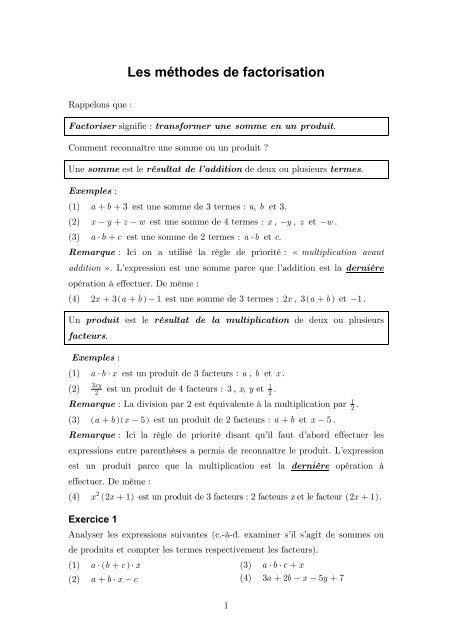
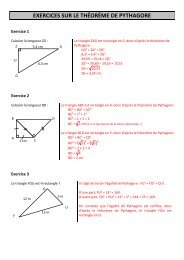
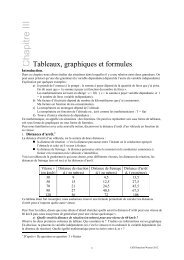

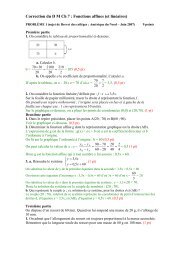
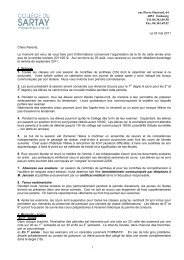

![[Document d'intentions pédagogiques] - Collège du Sartay](https://img.yumpu.com/49774314/1/184x260/document-dintentions-pacdagogiques-collage-du-sartay.jpg?quality=85)
